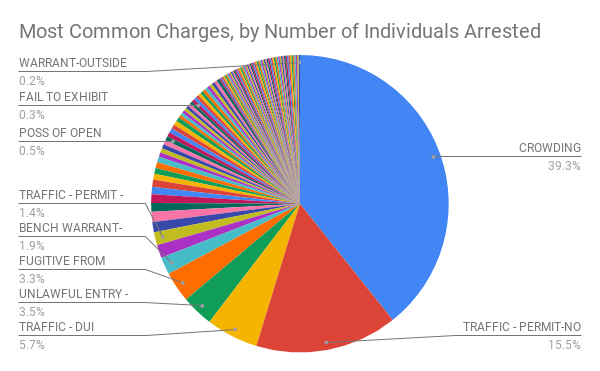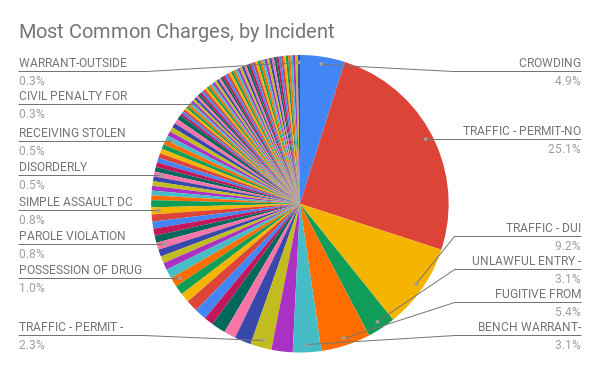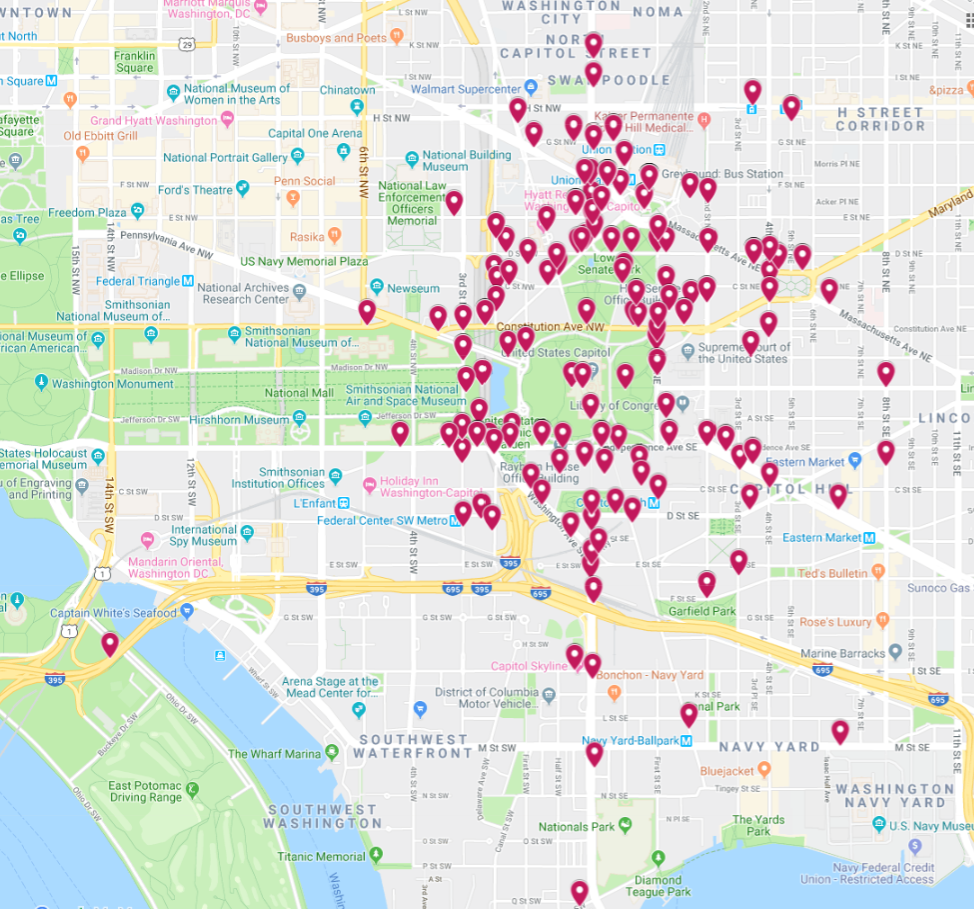It’s been a little over six months since the U.S. Capitol Police (USCP) started posting arrest summaries. Here’s what the data tell us:
Between December 19, 2018 and June 24, 2019 USCP disclosed 271 incidents where 531 individuals were arrested. Incidents can involve more than one individual getting arrested, which explains the gap in those two figures. Of these 271 incidents:
- 13.7% (37 incidents) took place at or around Union Station, with 54% (20) of those incidents involving drugs.
- 12.5% (34 incidents) took place in congressional office buildings and the Capitol or directly adjacent to those buildings. 188 individuals were arrested during these incidents.
- The most common charges issued: 36% of incidents included charges for driving without a valid license (98 incidents) and 13% of incidents included charges for driving under the influence of alcohol or drugs (36 incidents).
• • •
USCP’s budget for Fiscal Year 2019 was over $455 million. Even adjusting for inflation, that’s 3.5 times the size of the department’s 1999 budget and it constitutes almost 10% of the $4.8 billion legislative branch budget. The USCP budget is a little bigger than the budget for the Austin, Texas police department, which serves a population of 950,000 people.
Unlike most police forces, the U.S. Capitol Police’s mission is focused on keeping Congress safe so that it can fulfill its constitutional and legislative responsibilities. The track record for arrests suggest that there may be a partial misalignment between where the police are expending effort and where its attention is most needed.
Keeping Congress safe is no easy feat, especially where threats against members are becoming more common and threaten to disrupt our democracy. That said, the full mission of the department is to protect “the Congress – its Members, employees, visitors, and facilities – so it can fulfill its constitutional and legislative responsibilities in a safe, secure and open environment.”
Last fall, we started elevating questions about how the department was keeping Congress safe while keeping it open. We wanted to know, for example, what happens to protesters arrested on Capitol grounds, who is the department arresting, and more broadly, are the Capitol Police’s resources focused on keeping Congress safe and open?
• • •
In December, USCP began publishing arrest summaries online, which we’ve turned into a dataset. These summaries do not present an accurate snapshot of what’s going on (more details on that below), but here’s what we know:
The most common arrest charges are for driving without a proper license, driving under the influence, being a fugitive from justice, and obstructing common spaces while protesting. Visual representations of the arrest trends (Figures 1, 2, and 3) can be found at the end of this article.
More incidents occur near Union Station than inside Congressional office buildings. USCP aims to maintain a secure perimeter by keeping incidents as far from member offices as possible. While this may justify some incidents beyond Congress’s halls, policing drug users at Union Station seems to be out of the scope of the department’s mission and could divert attention away from more important tasks.
More than half of the Union Station incidents (20 out of 37) are predicated on officers approaching individuals for drug use or finding drugs on individuals they’re interacting with. To see where else Capitol Police arrests are occuring you can check out the map we pulled together from arrest data online here or as a still image below (Figure 4).
We are not sure what types of arrests are happening or how frequently because the arrest summaries ironically do not appear to reflect all arrests. It would be helpful for USCP to publish a list of what activities are not included in the arrest summaries on its website so researchers and advocates can tell what pieces of the puzzle are missing.
We welcome today’s House Administration Committee oversight hearing on the US Capitol Police and we will continue to follow this issue.
• • •
Figure 1. Most Common Charges Issued by USCP, December 2018-June 2019
| Charge | No. of Incidents | No. of Individuals Arrested |
| TRAFFIC – PERMIT-NO VALID | 98 | 98 |
| TRAFFIC – DUI ALCOHOL OR DRUGS | 36 | 36 |
| FUGITIVE FROM JUSTICE | 21 | 21 |
| CROWDING OBSTRUCTING INCOMMODING DC CODE 22-1307 | 19 | 249 |
| BENCH WARRANT-MISDEMEANOR | 12 | 12 |
| UNLAWFUL ENTRY – MISD | 12 | 22 |
| RESISTING ARREST | 9 | 9 |
| TRAFFIC – PERMIT -OPERATING AFTER REVOCATION | 9 | 9 |
| ASSAULT ON A POLICE OFFICER – MISDEMEANOR | 7 | 7 |
| UUV – FELONY | 6 | 6 |
| UCSA – POSSESSION OF DRUG PARAPHERNALIA – MISD | 5 | 7 |
Figure 2.

Figure 3.

Figure 4. Map of USCP Arrests, December 2018-June 2019

Download this report as a PDF here.
— Written by Amelia Strauss
Updated on August 7, 2019 to include a more precise version of the arrest map.
Related reading: